This is the eBook of the printed book and may not include any media, website access codes, or print supplements that may come packaged with the bound book.
Intended primarily for courses in Computer Concepts and Office Applications, this text also provides practical content to current and aspiring industry professionals.
One Book. Everything You Need.
GO! All In One, Second Edition teaches computer concepts and applications together — the way it is in the real world! It engages students right away by using a jobs-focused approach that integrates computer concepts and applications into practical combinations of concepts and skills in the context of a job. With this approach students learn how to work in the real world where they will solve problems using computer concepts and skills related to the Internet, Microsoft Office 2013 applications, collaboration, social media, and cloud computing.
Also available with MyITLab®
This title is also available with MyITLab –a fully integrated learning system that includes Grader projects, training and assessment simulations, the Pearson eText, and all of the student and instructor resources in one place! MyITLab personalizes learning to help your students better prepare for class, quizzes, and exams–resulting in more dynamic experiences in the classroom and improved performance in the course.
Students, if interested in purchasing this title with MyITLab, ask your instructor for the correct package ISBN. Instructors, contact your Pearson representative for more information.








